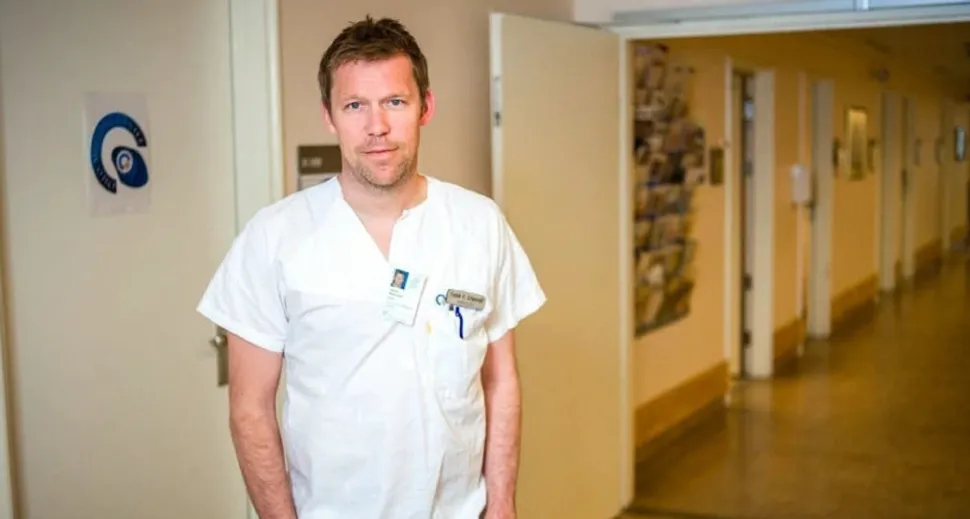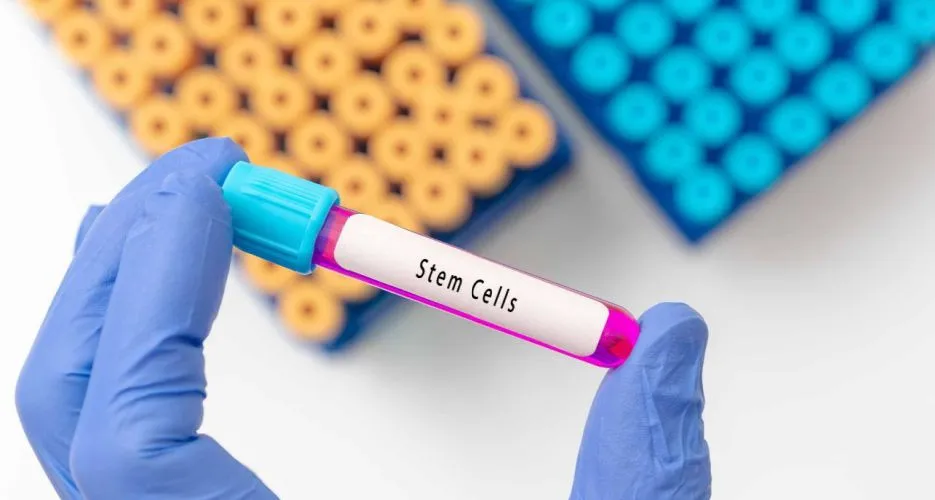Expanding Clinical Trials: Norway’s Gift to Myeloma?

Imagine a world in which specialists went to physicians treating myeloma patients with opportunities for them to take part in clinical trials. Sounds like a wonderful alternative compared to what happens today: patients actively seeking trials out for themselves, hoping their physician mentions one as a treatment option, or randomly runs across a clinical trial in an online article.
Clinical trials are essential, for better or worse, to advance knowledge in any disease. Yet getting the right people into clinical trials is still a haphazard process dependent on specialized knowledge, professional relationships and yes, far too often, random luck.
Dr. Fredrik Schjesvold (pronounced sh-ess-vold) recognized this problem as a PhD candidate a decade ago. His idea, one that is “pretty unique in all cancers,” created the Oslo Myeloma Center to conduct and increase participation in trials. In addition to its own work, the Center provides expertise, support, and active outreach to work with institutions throughout Norway to identify the right doctors and patients for the right trial.
Today that program includes five PhDs, three of whom focus on clinical studies, fifteen study nurses, five secretaries and four project coordinators. Together, they oversee various myeloma clinical trial participants throughout the nation, and perhaps soon, will influence all the NMSG-member nations to do the same.
They actively stay in touch with, inform and expand trials participation by reaching out to fellow community hematologist-oncologists. It would have been different years ago.
“In Norway, if you want to have time to do clinical research, you started with a project and a PhD to get money for that project,” said Schjesvold, “We did it the other way around. We started by participating in other peoples’ trials. After a couple of years we established an infrastructure to do research and studies on our own.”
At the time, Dr. Ola Landgren was setting up a myeloma center of excellence at Memorial Sloan Kettering Cancer Center, adding to Schjesvold’s vision, the idea that focused as much activity as possible on one disease, which was not common in Europe.
Under his leadership, in less than ten years after thinking about it on flight, Schjesvold leads a program that might well serve as a model to benefit patients in the clinic faster. As the newly elected president of the Nordic Myeloma Study Group (NMSG)*, he has the opportunity to implement his ideas through Scandinavian and Balkan nations.
In 2013, Norway was not on the clinical trials map, globally speaking. This initiative currently has sixteen open and enrolling clinical trials and collaborates in trials throughout Europe, which is now approaching 60, all focused on individual patients.
“We went from Norway always being the smallest child in the class,” reminisced Schjesvold, "to being the biggest center in the Nordics.”
Creating, Building, Adding
Norway is known as having one of, if not THE, best public healthcare systems in the world. Common to all systems in the world, keeping costs under control are a paramount concern; it’s not an issue for patients in Norway, but it is very much so for governing officials.
Schjesvold saw an unfulfilled opportunity to link trials sponsored by pharmaceutical companies—the ones that are critical in the approval of new drugs and treatments—and created a program that now adds revenue, not costs, to the Norwegian health system, because costs for trials are largely funded by companies.
“Now it seems that we have,” summed up Schjesvold, “passed that threshold to struggle to get trials.” When he first approached companies, he faced a Catch-22 familiar to anyone embarking on a new venture, you had to have experience to get more experience. “For a long time, we struggled to get the phase one trials because there are fewer sites and participants are more ‘handpicked.’”
Additionally, “there was a rule that two sites in a country are needed to open a contract.” This can be difficult “to help convince them” if you are in a nation of just under 5.5 million, which would rank it between Minnesota and South Carolina. This is a geographic area that would approximate (not including the Svalbard island group) a diagonal north to south similar to the distance from the central Montana-Canada border to Santa Barbara, CA.
“I really pushed companies to say, ‘get outside of your footprint, include Norway, even if it's just one site’,” recalls Schjesvold. “They were really sick of me, but I managed to talk to the global boss of one and I was able to persuade them to include Norway, which was very much outside of what they were doing.”
OPTIMISM was “one of our first studies,” Schjesvold remembered, “it was really struggling to recruit, so we came in as a rescue site at the end, but we were still able to enroll the third highest number in that study, which was sort of a breakthrough.” This was one of the early studies that got them on the map, so to speak.
Over a short time, the Oslo Myeloma Center began enrolling patients in big trials familiar to knowledgable patients as well as “several phase one trials” which “unfortunately”, aren’t always “a success, efficacy-wise, but that's phase one” which “are very important too, because next time they ask you, have you had the phase one trial, have you had the CAR T trial? So those are sort of big milestones.
“And while not always a success, it is important to remember that phase one trials are opportunities for patients who have tried ‘everything,’ which is why they are very popular with them,” Schejesvold observed.
“In the last nine months we had to say no to 10-15 trials from different companies, something older, larger centers have experienced a lot, but it is new for us,” he continued. “That's the major thing for a small country. We actually have come from nothing in 2014, to be a place in 2021 where most companies, I would say, come to us to be part of their trials. I used of kind of hassled the bosses around, “it seems like now I don't have to go hassle people in the morning.”
Two Great Opportunities
“When you start to combine therapies and treatments,” speculated Schejesvold about the future of myeloma, “and put them in first line, we’re going to cure a lot of patients.”
As he surveys the opportunity in myeloma, two research areas intrigue Schjesvold: CAR T and iStoppMM study in Iceland.
“There's now clinical data on GPRC5D in CAR T, and I think there’s just so much to gain from having many drugs targeting the same BCMA, we need to move to the next targets. I think it's extremely important that this mechanism of action is the most efficacious we have ever seen in myeloma with the use of bispecifics and CAR T. New targets will also have good clinical efficacy,” predicted Schjesvold.
The IStopMM trial in Iceland, which monitors the nation’s population for MGUS and myeloma is conducted in the “only country in the world that could do it. There's so much elegance here. You just send out electronically a consent form, which most people agreed to. With only one lab system in Iceland [with a population approaching 390,000], all labs automatically take a sample for the study and then they don't hear about it again unless they have an MGUS and are randomized to a study.”
Of the 60,000-plus screenings, 24 myeloma patients have been found. According to Schjesvold, “it's very difficult to learn if population screening benefits the [intended] population, we need to wait for more results.”
“But the study also creates a lot of other epidemiological knowledge that we didn't have,” said Schjesvold summing up the connections between the two research trends. “With the data on CARTITUDE-1, it’s like another world from what we have seen before in late line patients.”
“It’s really lifting the spirit of myeloma.”
Hematology: Not Engineering, Definitely Not Mice!
“I had no intention of doing anything I'm doing,” Schjesvold recalled. From his home town of Bodø, just north of the Arctic Circle, Schjesvold knew he wanted to do something interesting and important and go to the big city to study.
“I went to medical school because a friend of mine moved to Oslo. Instead of going into engineering, which was also physics and mathematics, I ended up in medicine. At the final exam, I was questioned by a hematologist who then offered me a short-term job. I accepted.”
Sometimes the most seemingly minor decisions we make are the most monumental.
After graduating to become a hospital consultant, he attended his first NMSG meeting. After a year of working with myeloma mouse models, Schjesvold “found out working in labs with mice was not for me” and eventually made his way back to a hospital in Oslo and is now president of NMSG.
Thankfully, Schjesvold chose myeloma patients over engineering and mice to conceptualize solutions to problems. Great ideas are often so simple and obvious in retrospect. Being the first to see or try one is not.
* The Nordic Myeloma Study Group (NMSG) member nations include, in order of population size, Sweden, Denmark, Finland, Norway, Lithuania, Estonia, and Iceland. The combined population of approximately 32 million would place it slightly higher than Texas, the second most populous state, representing just more than nine percent of the U.S. population.
Combined, the land area covered by the NMSG is roughly equivalent to the size of the continental U.S. west of the Rocky Mountains.
Photo Credit: Øystein Horgmo/University of Oslo
Imagine a world in which specialists went to physicians treating myeloma patients with opportunities for them to take part in clinical trials. Sounds like a wonderful alternative compared to what happens today: patients actively seeking trials out for themselves, hoping their physician mentions one as a treatment option, or randomly runs across a clinical trial in an online article.
Clinical trials are essential, for better or worse, to advance knowledge in any disease. Yet getting the right people into clinical trials is still a haphazard process dependent on specialized knowledge, professional relationships and yes, far too often, random luck.
Dr. Fredrik Schjesvold (pronounced sh-ess-vold) recognized this problem as a PhD candidate a decade ago. His idea, one that is “pretty unique in all cancers,” created the Oslo Myeloma Center to conduct and increase participation in trials. In addition to its own work, the Center provides expertise, support, and active outreach to work with institutions throughout Norway to identify the right doctors and patients for the right trial.
Today that program includes five PhDs, three of whom focus on clinical studies, fifteen study nurses, five secretaries and four project coordinators. Together, they oversee various myeloma clinical trial participants throughout the nation, and perhaps soon, will influence all the NMSG-member nations to do the same.
They actively stay in touch with, inform and expand trials participation by reaching out to fellow community hematologist-oncologists. It would have been different years ago.
“In Norway, if you want to have time to do clinical research, you started with a project and a PhD to get money for that project,” said Schjesvold, “We did it the other way around. We started by participating in other peoples’ trials. After a couple of years we established an infrastructure to do research and studies on our own.”
At the time, Dr. Ola Landgren was setting up a myeloma center of excellence at Memorial Sloan Kettering Cancer Center, adding to Schjesvold’s vision, the idea that focused as much activity as possible on one disease, which was not common in Europe.
Under his leadership, in less than ten years after thinking about it on flight, Schjesvold leads a program that might well serve as a model to benefit patients in the clinic faster. As the newly elected president of the Nordic Myeloma Study Group (NMSG)*, he has the opportunity to implement his ideas through Scandinavian and Balkan nations.
In 2013, Norway was not on the clinical trials map, globally speaking. This initiative currently has sixteen open and enrolling clinical trials and collaborates in trials throughout Europe, which is now approaching 60, all focused on individual patients.
“We went from Norway always being the smallest child in the class,” reminisced Schjesvold, "to being the biggest center in the Nordics.”
Creating, Building, Adding
Norway is known as having one of, if not THE, best public healthcare systems in the world. Common to all systems in the world, keeping costs under control are a paramount concern; it’s not an issue for patients in Norway, but it is very much so for governing officials.
Schjesvold saw an unfulfilled opportunity to link trials sponsored by pharmaceutical companies—the ones that are critical in the approval of new drugs and treatments—and created a program that now adds revenue, not costs, to the Norwegian health system, because costs for trials are largely funded by companies.
“Now it seems that we have,” summed up Schjesvold, “passed that threshold to struggle to get trials.” When he first approached companies, he faced a Catch-22 familiar to anyone embarking on a new venture, you had to have experience to get more experience. “For a long time, we struggled to get the phase one trials because there are fewer sites and participants are more ‘handpicked.’”
Additionally, “there was a rule that two sites in a country are needed to open a contract.” This can be difficult “to help convince them” if you are in a nation of just under 5.5 million, which would rank it between Minnesota and South Carolina. This is a geographic area that would approximate (not including the Svalbard island group) a diagonal north to south similar to the distance from the central Montana-Canada border to Santa Barbara, CA.
“I really pushed companies to say, ‘get outside of your footprint, include Norway, even if it's just one site’,” recalls Schjesvold. “They were really sick of me, but I managed to talk to the global boss of one and I was able to persuade them to include Norway, which was very much outside of what they were doing.”
OPTIMISM was “one of our first studies,” Schjesvold remembered, “it was really struggling to recruit, so we came in as a rescue site at the end, but we were still able to enroll the third highest number in that study, which was sort of a breakthrough.” This was one of the early studies that got them on the map, so to speak.
Over a short time, the Oslo Myeloma Center began enrolling patients in big trials familiar to knowledgable patients as well as “several phase one trials” which “unfortunately”, aren’t always “a success, efficacy-wise, but that's phase one” which “are very important too, because next time they ask you, have you had the phase one trial, have you had the CAR T trial? So those are sort of big milestones.
“And while not always a success, it is important to remember that phase one trials are opportunities for patients who have tried ‘everything,’ which is why they are very popular with them,” Schejesvold observed.
“In the last nine months we had to say no to 10-15 trials from different companies, something older, larger centers have experienced a lot, but it is new for us,” he continued. “That's the major thing for a small country. We actually have come from nothing in 2014, to be a place in 2021 where most companies, I would say, come to us to be part of their trials. I used of kind of hassled the bosses around, “it seems like now I don't have to go hassle people in the morning.”
Two Great Opportunities
“When you start to combine therapies and treatments,” speculated Schejesvold about the future of myeloma, “and put them in first line, we’re going to cure a lot of patients.”
As he surveys the opportunity in myeloma, two research areas intrigue Schjesvold: CAR T and iStoppMM study in Iceland.
“There's now clinical data on GPRC5D in CAR T, and I think there’s just so much to gain from having many drugs targeting the same BCMA, we need to move to the next targets. I think it's extremely important that this mechanism of action is the most efficacious we have ever seen in myeloma with the use of bispecifics and CAR T. New targets will also have good clinical efficacy,” predicted Schjesvold.
The IStopMM trial in Iceland, which monitors the nation’s population for MGUS and myeloma is conducted in the “only country in the world that could do it. There's so much elegance here. You just send out electronically a consent form, which most people agreed to. With only one lab system in Iceland [with a population approaching 390,000], all labs automatically take a sample for the study and then they don't hear about it again unless they have an MGUS and are randomized to a study.”
Of the 60,000-plus screenings, 24 myeloma patients have been found. According to Schjesvold, “it's very difficult to learn if population screening benefits the [intended] population, we need to wait for more results.”
“But the study also creates a lot of other epidemiological knowledge that we didn't have,” said Schjesvold summing up the connections between the two research trends. “With the data on CARTITUDE-1, it’s like another world from what we have seen before in late line patients.”
“It’s really lifting the spirit of myeloma.”
Hematology: Not Engineering, Definitely Not Mice!
“I had no intention of doing anything I'm doing,” Schjesvold recalled. From his home town of Bodø, just north of the Arctic Circle, Schjesvold knew he wanted to do something interesting and important and go to the big city to study.
“I went to medical school because a friend of mine moved to Oslo. Instead of going into engineering, which was also physics and mathematics, I ended up in medicine. At the final exam, I was questioned by a hematologist who then offered me a short-term job. I accepted.”
Sometimes the most seemingly minor decisions we make are the most monumental.
After graduating to become a hospital consultant, he attended his first NMSG meeting. After a year of working with myeloma mouse models, Schjesvold “found out working in labs with mice was not for me” and eventually made his way back to a hospital in Oslo and is now president of NMSG.
Thankfully, Schjesvold chose myeloma patients over engineering and mice to conceptualize solutions to problems. Great ideas are often so simple and obvious in retrospect. Being the first to see or try one is not.
* The Nordic Myeloma Study Group (NMSG) member nations include, in order of population size, Sweden, Denmark, Finland, Norway, Lithuania, Estonia, and Iceland. The combined population of approximately 32 million would place it slightly higher than Texas, the second most populous state, representing just more than nine percent of the U.S. population.
Combined, the land area covered by the NMSG is roughly equivalent to the size of the continental U.S. west of the Rocky Mountains.
Photo Credit: Øystein Horgmo/University of Oslo

about the author
Greg Brozeit
Greg Brozeit has been with the HealthTree Foundation since 2015 when he began volunteering for the Myeloma Crowd. Prior to that he worked with Dr. Bart Barlogie and the International Myeloma Foundation, inaugurating many myeloma patient advocacy and education programs.
More on Treatment Advances
Trending Articles




Get the Latest Multiple Myeloma Updates, Delivered to You.
By subscribing to the HealthTree newsletter, you'll receive the latest research, treatment updates, and expert insights to help you navigate your health.
Together we care.
Together we cure.
3x Faster.












